Hao Yin
CCL-LGS: Contrastive Codebook Learning for 3D Language Gaussian Splatting
May 26, 2025Abstract:Recent advances in 3D reconstruction techniques and vision-language models have fueled significant progress in 3D semantic understanding, a capability critical to robotics, autonomous driving, and virtual/augmented reality. However, methods that rely on 2D priors are prone to a critical challenge: cross-view semantic inconsistencies induced by occlusion, image blur, and view-dependent variations. These inconsistencies, when propagated via projection supervision, deteriorate the quality of 3D Gaussian semantic fields and introduce artifacts in the rendered outputs. To mitigate this limitation, we propose CCL-LGS, a novel framework that enforces view-consistent semantic supervision by integrating multi-view semantic cues. Specifically, our approach first employs a zero-shot tracker to align a set of SAM-generated 2D masks and reliably identify their corresponding categories. Next, we utilize CLIP to extract robust semantic encodings across views. Finally, our Contrastive Codebook Learning (CCL) module distills discriminative semantic features by enforcing intra-class compactness and inter-class distinctiveness. In contrast to previous methods that directly apply CLIP to imperfect masks, our framework explicitly resolves semantic conflicts while preserving category discriminability. Extensive experiments demonstrate that CCL-LGS outperforms previous state-of-the-art methods. Our project page is available at https://epsilontl.github.io/CCL-LGS/.
Decoupled Geometric Parameterization and its Application in Deep Homography Estimation
May 22, 2025



Abstract:Planar homography, with eight degrees of freedom (DOFs), is fundamental in numerous computer vision tasks. While the positional offsets of four corners are widely adopted (especially in neural network predictions), this parameterization lacks geometric interpretability and typically requires solving a linear system to compute the homography matrix. This paper presents a novel geometric parameterization of homographies, leveraging the similarity-kernel-similarity (SKS) decomposition for projective transformations. Two independent sets of four geometric parameters are decoupled: one for a similarity transformation and the other for the kernel transformation. Additionally, the geometric interpretation linearly relating the four kernel transformation parameters to angular offsets is derived. Our proposed parameterization allows for direct homography estimation through matrix multiplication, eliminating the need for solving a linear system, and achieves performance comparable to the four-corner positional offsets in deep homography estimation.
The Mirage of Performance Gains: Why Contrastive Decoding Fails to Address Multimodal Hallucination
Apr 14, 2025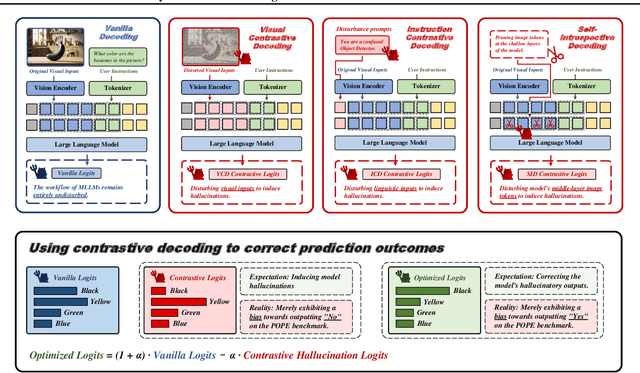
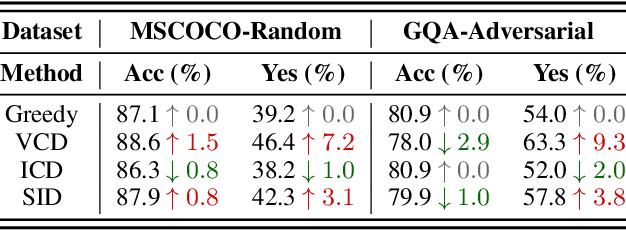


Abstract:Contrastive decoding strategies are widely used to reduce hallucinations in multimodal large language models (MLLMs). These methods work by constructing contrastive samples to induce hallucinations and then suppressing them in the output distribution. However, this paper demonstrates that such approaches fail to effectively mitigate the hallucination problem. The performance improvements observed on POPE Benchmark are largely driven by two misleading factors: (1) crude, unidirectional adjustments to the model's output distribution and (2) the adaptive plausibility constraint, which reduces the sampling strategy to greedy search. To further illustrate these issues, we introduce a series of spurious improvement methods and evaluate their performance against contrastive decoding techniques. Experimental results reveal that the observed performance gains in contrastive decoding are entirely unrelated to its intended goal of mitigating hallucinations. Our findings challenge common assumptions about the effectiveness of contrastive decoding strategies and pave the way for developing genuinely effective solutions to hallucinations in MLLMs.
EvMic: Event-based Non-contact sound recovery from effective spatial-temporal modeling
Apr 03, 2025Abstract:When sound waves hit an object, they induce vibrations that produce high-frequency and subtle visual changes, which can be used for recovering the sound. Early studies always encounter trade-offs related to sampling rate, bandwidth, field of view, and the simplicity of the optical path. Recent advances in event camera hardware show good potential for its application in visual sound recovery, because of its superior ability in capturing high-frequency signals. However, existing event-based vibration recovery methods are still sub-optimal for sound recovery. In this work, we propose a novel pipeline for non-contact sound recovery, fully utilizing spatial-temporal information from the event stream. We first generate a large training set using a novel simulation pipeline. Then we designed a network that leverages the sparsity of events to capture spatial information and uses Mamba to model long-term temporal information. Lastly, we train a spatial aggregation block to aggregate information from different locations to further improve signal quality. To capture event signals caused by sound waves, we also designed an imaging system using a laser matrix to enhance the gradient and collected multiple data sequences for testing. Experimental results on synthetic and real-world data demonstrate the effectiveness of our method.
ClearSight: Visual Signal Enhancement for Object Hallucination Mitigation in Multimodal Large language Models
Mar 17, 2025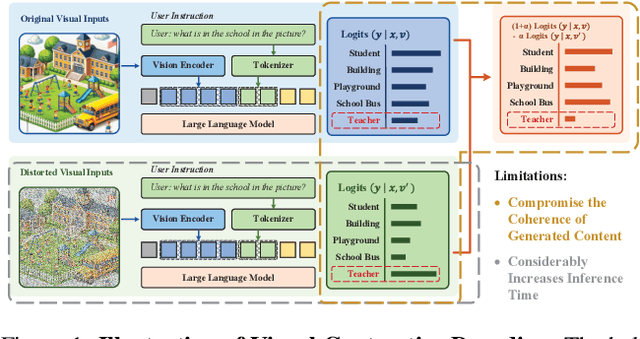

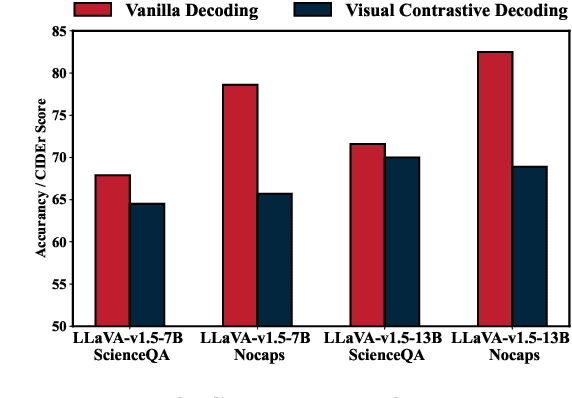

Abstract:Contrastive decoding strategies are widely used to mitigate object hallucinations in multimodal large language models (MLLMs). By reducing over-reliance on language priors, these strategies ensure that generated content remains closely grounded in visual inputs, producing contextually accurate outputs. Since contrastive decoding requires no additional training or external tools, it offers both computational efficiency and versatility, making it highly attractive. However, these methods present two main limitations: (1) bluntly suppressing language priors can compromise coherence and accuracy of generated content, and (2) processing contrastive inputs adds computational load, significantly slowing inference speed. To address these challenges, we propose Visual Amplification Fusion (VAF), a plug-and-play technique that enhances attention to visual signals within the model's middle layers, where modality fusion predominantly occurs. This approach enables more effective capture of visual features, reducing the model's bias toward language modality. Experimental results demonstrate that VAF significantly reduces hallucinations across various MLLMs without affecting inference speed, while maintaining coherence and accuracy in generated outputs.
Lifting the Veil on Visual Information Flow in MLLMs: Unlocking Pathways to Faster Inference
Mar 17, 2025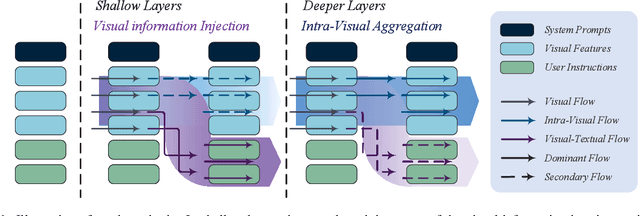
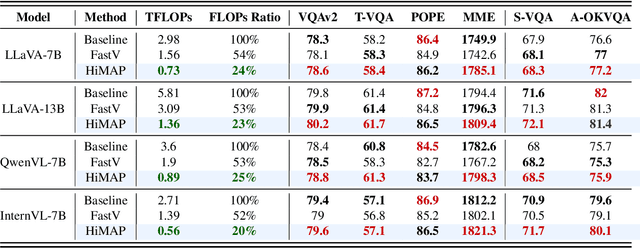
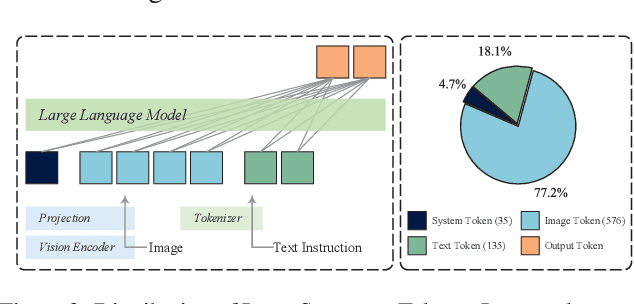
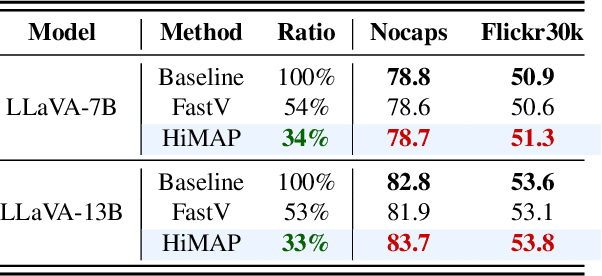
Abstract:Multimodal large language models (MLLMs) improve performance on vision-language tasks by integrating visual features from pre-trained vision encoders into large language models (LLMs). However, how MLLMs process and utilize visual information remains unclear. In this paper, a shift in the dominant flow of visual information is uncovered: (1) in shallow layers, strong interactions are observed between image tokens and instruction tokens, where most visual information is injected into instruction tokens to form cross-modal semantic representations; (2) in deeper layers, image tokens primarily interact with each other, aggregating the remaining visual information to optimize semantic representations within visual modality. Based on these insights, we propose Hierarchical Modality-Aware Pruning (HiMAP), a plug-and-play inference acceleration method that dynamically prunes image tokens at specific layers, reducing computational costs by approximately 65% without sacrificing performance. Our findings offer a new understanding of visual information processing in MLLMs and provide a state-of-the-art solution for efficient inference.
A Decade of Action Quality Assessment: Largest Systematic Survey of Trends, Challenges, and Future Directions
Feb 05, 2025



Abstract:Action Quality Assessment (AQA) -- the ability to quantify the quality of human motion, actions, or skill levels and provide feedback -- has far-reaching implications in areas such as low-cost physiotherapy, sports training, and workforce development. As such, it has become a critical field in computer vision & video understanding over the past decade. Significant progress has been made in AQA methodologies, datasets, & applications, yet a pressing need remains for a comprehensive synthesis of this rapidly evolving field. In this paper, we present a thorough survey of the AQA landscape, systematically reviewing over 200 research papers using the preferred reporting items for systematic reviews & meta-analyses (PRISMA) framework. We begin by covering foundational concepts & definitions, then move to general frameworks & performance metrics, & finally discuss the latest advances in methodologies & datasets. This survey provides a detailed analysis of research trends, performance comparisons, challenges, & future directions. Through this work, we aim to offer a valuable resource for both newcomers & experienced researchers, promoting further exploration & progress in AQA. Data are available at https://haoyin116.github.io/Survey_of_AQA/
Perturbation Ontology based Graph Attention Networks
Nov 27, 2024

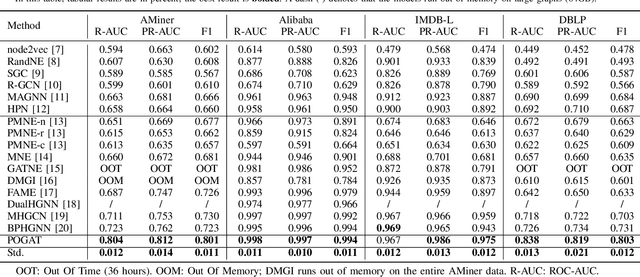
Abstract:In recent years, graph representation learning has undergone a paradigm shift, driven by the emergence and proliferation of graph neural networks (GNNs) and their heterogeneous counterparts. Heterogeneous GNNs have shown remarkable success in extracting low-dimensional embeddings from complex graphs that encompass diverse entity types and relationships. While meta-path-based techniques have long been recognized for their ability to capture semantic affinities among nodes, their dependence on manual specification poses a significant limitation. In contrast, matrix-focused methods accelerate processing by utilizing structural cues but often overlook contextual richness. In this paper, we challenge the current paradigm by introducing ontology as a fundamental semantic primitive within complex graphs. Our goal is to integrate the strengths of both matrix-centric and meta-path-based approaches into a unified framework. We propose perturbation Ontology-based Graph Attention Networks (POGAT), a novel methodology that combines ontology subgraphs with an advanced self-supervised learning paradigm to achieve a deep contextual understanding. The core innovation of POGAT lies in our enhanced homogeneous perturbing scheme designed to generate rigorous negative samples, encouraging the model to explore minimal contextual features more thoroughly. Through extensive empirical evaluations, we demonstrate that POGAT significantly outperforms state-of-the-art baselines, achieving a groundbreaking improvement of up to 10.78\% in F1-score for the critical task of link prediction and 12.01\% in Micro-F1 for the critical task of node classification.
Navigating Spatial Inequities in Freight Truck Crash Severity via Counterfactual Inference in Los Angeles
Nov 26, 2024



Abstract:Freight truck-related crashes pose significant challenges, leading to substantial economic losses, injuries, and fatalities, with pronounced spatial disparities across different regions. This study adopts a transport geography perspective to examine spatial justice concerns by employing deep counterfactual inference models to analyze how socioeconomic disparities, road infrastructure, and environmental conditions influence the geographical distribution and severity of freight truck crashes. By integrating road network datasets, socioeconomic attributes, and crash records from the Los Angeles metropolitan area, this research provides a nuanced spatial analysis of how different communities are disproportionately impacted. The results reveal significant spatial disparities in crash severity across areas with varying population densities, income levels, and minority populations, highlighting the pivotal role of infrastructural and environmental improvements in mitigating these disparities. The findings offer insights into targeted, location-specific policy interventions, suggesting enhancements in road infrastructure, lighting, and traffic control systems, particularly in low-income and minority-concentrated areas. This research contributes to the literature on transport geography and spatial equity by providing data-driven insights into effective measures for reducing spatial injustices associated with freight truck-related crashes.
EvSign: Sign Language Recognition and Translation with Streaming Events
Jul 17, 2024


Abstract:Sign language is one of the most effective communication tools for people with hearing difficulties. Most existing works focus on improving the performance of sign language tasks on RGB videos, which may suffer from degraded recording conditions, such as fast movement of hands with motion blur and textured signer's appearance. The bio-inspired event camera, which asynchronously captures brightness change with high speed, could naturally perceive dynamic hand movements, providing rich manual clues for sign language tasks. In this work, we aim at exploring the potential of event camera in continuous sign language recognition (CSLR) and sign language translation (SLT). To promote the research, we first collect an event-based benchmark EvSign for those tasks with both gloss and spoken language annotations. EvSign dataset offers a substantial amount of high-quality event streams and an extensive vocabulary of glosses and words, thereby facilitating the development of sign language tasks. In addition, we propose an efficient transformer-based framework for event-based SLR and SLT tasks, which fully leverages the advantages of streaming events. The sparse backbone is employed to extract visual features from sparse events. Then, the temporal coherence is effectively utilized through the proposed local token fusion and gloss-aware temporal aggregation modules. Extensive experimental results are reported on both simulated (PHOENIX14T) and EvSign datasets. Our method performs favorably against existing state-of-the-art approaches with only 0.34% computational cost (0.84G FLOPS per video) and 44.2% network parameters. The project is available at https://zhang-pengyu.github.io/EVSign.
 Add to Chrome
Add to Chrome Add to Firefox
Add to Firefox Add to Edge
Add to Edge